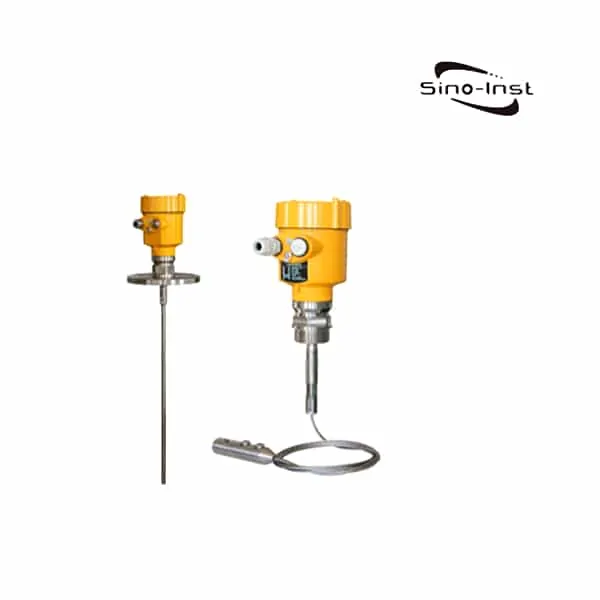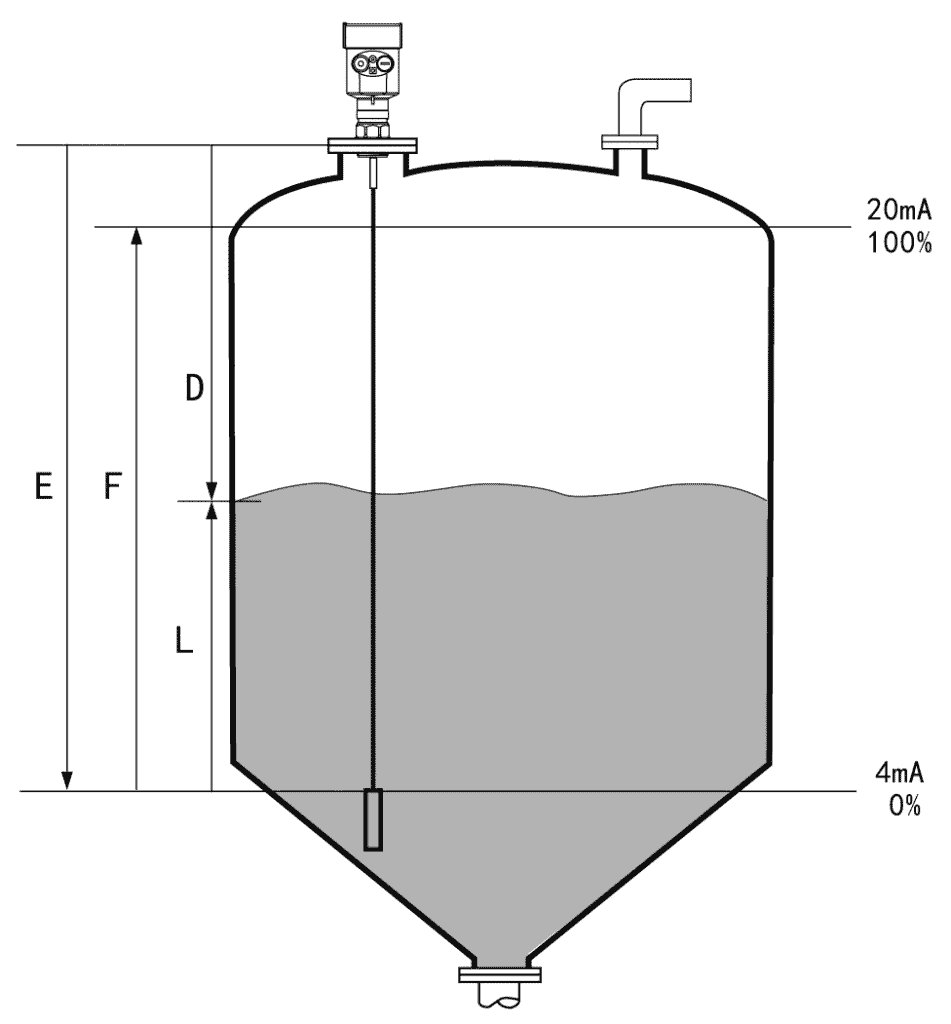Guided Wave Radar Level Sensor for Liquid and Bulk Solids Contact level measurement.

Guided wave radar is a measuring instrument based on the principle of time travel. The radar wave runs at the speed of light. The operating time can be converted into level signals by electronic components. The probe emits high-frequency pulses and propagates along the cable or rod probe. When the pulse meets the surface of the material, it is reflected back and received by the receiver in the instrument. And convert the distance signal into level signal. SIRD-701 Guided Wave Radar Level Sensor is suitable for liquid and Bulk Solids measurement, and complex process conditions.
Sino-Inst offers a variety of Guided wave radar Level Sensors for industrial level measurement. If you have any questions, please contact our sales engineers.
Features of Guided Wave Radar Level Sensor
Guided wave radar level sensor can be used for continuous measurement of liquids, slurries and granular materials with relatively low dielectric constants. It is suitable for applications where the temperature, pressure changes greatly, and there is inert gas or steam. And has the following characteristics:
1. Strong versatility. Guided wave radar level sensor can continuously measure the level of liquid, solid and powder particles. Choose different probes according to different working conditions. The main probes are divided into three types. They are cable probes, rod probes and coaxial rods. The maximum measurement distance of the cable probe can reach 35 meters. And it has a good measurement effect on the measurement of liquid and solid material levels. Rod probes are mainly used for liquids. Coaxial rod probes are used for liquids and can be used in harsh working conditions such as corrosion and impact.
2. Prevent hanging material. The circuit design and sensor structure of the guided wave radar level gauge make it unaffected during the measurement. It does not require regular maintenance and cleaning to avoid delaying the measurement.
3. Maintenance free. There are no moving parts in the measurement process. integrated design. There is no damage maintenance problem.
4. Strong anti-interference. Guided wave radar level meter uses contact measurement. Strong anti-interference ability. It can also be measured stably under the working conditions containing steam, foam and stirring.
5. Accurate and reliable measurement. The measurement is more accurate. The measurement is not affected by environmental changes. High stability and long service life.
Specifications of Guided Wave Radar Level Sensor
- Suitable for Medium: Liquid, solid powder
- Application: Liquid and solid powder measure, complicated process conditions
- Explosion-proof Grade: Exia IIC T6 Ga/Exd IIC T6 Gb
- Measuring Range: 30m
- Frequency: 500MHz-1.8GHz
- Antenna: Single cable or single rod antenna
- Accuracy: ±10mm
- Process Temperature:(-40~250)℃
- Process pressure:(-0.1~4)MPa
- Signal output:(4~20)mA/HART
- The Scene Display: Four LCD/Can be programmed
- Power Source: Two-wire (DC24V)
- Four-wire(DC24V/AC220V)
- Shell: Aluminum /Plastic
- Connection: Flange (optional) / Thread
Extended reading: Radar Level Meter for Corrosive Liquids
Guided Wave Radar Level Sensor Working Principle

High-frequency microwave pulses from guided wave radar propagate along the detection component (steel cable or steel rod). When encountering the measured medium. Due to a sudden change in the dielectric constant, it causes reflection. A part of the pulse energy is reflected back. The time interval between the transmitted pulse and the reflected pulse is proportional to the distance of the measured medium.
Extended reading: FMCW Radar Level Transmitter 120GHz
Guided wave radar is a measuring instrument based on the principle of time travel. The radar wave runs at the speed of light. The running time can be converted into a level signal by electronic components. The probe emits high-frequency pulses and propagates along the cable or rod probe. When the pulse meets the surface of the material, it is reflected back and received by the receiver in the instrument, and the distance signal is converted into a level signal.
The reflected pulse signal is transmitted to the electronic circuit part of the instrument along the cable or rod probe. The microprocessor processes this signal. Identifies the echo generated by the microwave pulse on the surface of the material. The correct echo signal identification is done by the pulse software.
The distance D from the surface of the material is proportional to the time travel T of the pulse:
D=C×T/2
Where C is the speed of lightSince the distance E of the empty tank is known, the level L is:
L=E-D

Set by inputting empty tank height E (=zero point), full tank height F (=full scale) and some application parameters. The application parameters will automatically adapt the instrument to the measurement environment. Corresponding to 4-20mA output.
Ultrasonic Level versus Guided Wave Radar Level
Ultrasonic level sensors are non-contact and provide a cost-effective choice for most straight-wall tank applications. Guided wave radar sensors are suitable for liquid and solid applications and operate independently of process conditions.
Ultrasonic level measurement technology
The ultrasonic liquid level sensor operates by transmitting the sound wave generated by the piezoelectric transducer to the surface of the processing material to be measured. The level sensor measures the length of time it takes for the reflected sound wave to return to the transducer. Successful measurement depends on the reflection of ultrasonic waves from the process material and movement back to the sensor in a straight line. Factors such as dust, heavy steam, water tank obstacles, surface turbulence, foam, and even surface angle will affect the return signal when using an ultrasonic level sensor. It is therefore necessary to consider how the operating conditions affect the sound waves.
- Sound waves-Sound must travel through the medium (usually air). This makes the liquid level sensor unsuitable for use in vacuum applications where air molecules do not prevent sound waves from propagating.
- Surface Condition-Foam and other debris collected on the surface of the liquid will absorb sound waves and prevent them from returning to the sensor.
- Angle of incidence and angle of reflection-Sound waves must be sent and received in a straight line. And the reflective surface must be flat.
- Operating temperature-Ultrasonic devices are usually plastic with a maximum operating temperature of 60°C. In addition, varying process temperatures may produce inaccurate level readings.
- Working pressure-Ultrasonic equipment is not suitable for extreme pressure limits; the maximum working pressure should not exceed 30 psig.
- Environmental conditions-Steam, condensed moisture and other contaminants will change the speed of sound through the air. And greatly affect the accuracy of the returned signal. Therefore, ultrasonic equipment should be installed in a predictable environment.
Guided wave radar (GWR) level measurement
Guided wave radar (GWR) is a method of contact level measurement. It uses a probe to guide high-frequency electromagnetic waves from the level gauge to the measured medium.GWR is based on the principle of Time Domain Reflectometry (TDR). Using TDR, low-energy electromagnetic pulses are guided along the probe. When the pulse reaches the surface of the measured medium, the pulse energy is reflected by the probe to the circuit. The circuit then calculates the liquid level based on the time difference between the transmitted pulse and the received reflected pulse. The sensor can output the analyzed level as a continuous measurement reading through the analog output. Alternatively, the value can be converted into a freely positionable switch output signal.
- Unstable process conditions-changes in viscosity, density or acidity will not affect accuracy.
- Stirring surface-boiling surfaces, dust, foam and steam will not affect the performance of the device. GWR can also be used with circulating fluids, propeller mixers and aeration tanks.
- High temperature and high pressure-GWR performs well at temperatures up to 315°C and can withstand pressures up to 580 psig.
- Fine powders and viscous liquids-GWR is used with vacuum tanks containing used cooking oil and tanks filled with paint, latex, animal fat, soybean oil, sawdust, carbon black, titanium tetrachloride, salt and grains.

Extended reading: Radar level sensor for solids – Dust solid level measurement
FAQ
How does radar level sensor work?
The radar level sensor is a radar level gauge based on the principle of time domain reflection (TDR). The electromagnetic pulse of the radar liquid level sensor propagates along the steel cable or probe at the speed of light. When encountering the surface of the measured medium, part of the pulse of the radar liquid level sensor is reflected to form an echo and returns to the pulse transmitting device along the same path. The distance between the transmitting device and the surface of the measured medium is proportional to the propagation time of the pulse between them. The liquid level height is calculated.
What is GWR level transmitter?
GWR level transmitter is a guided wave radar level sensor.
How do you calibrate a radar level transmitter?
Three calibration methods:
①Display/debug module (View Point)
② PC debugging software
③HART handheld programmer
Sino-Inst offers over 10 Guided Wave Radar level transmitters for level measurement. About 50% of these are Radar level meters, 40% is the tank level sensor.
A wide variety of Guided Wave radar level meters options are available to you, such as free samples, paid samples.
Sino-Inst is a globally recognized supplier and manufacturer of Guided Wave radar level measurement instrumentation, located in China.
Request a Quote

Wu Peng, born in 1980, is a highly respected and accomplished male engineer with extensive experience in the field of automation. With over 20 years of industry experience, Wu has made significant contributions to both academia and engineering projects.
Throughout his career, Wu Peng has participated in numerous national and international engineering projects. Some of his most notable projects include the development of an intelligent control system for oil refineries, the design of a cutting-edge distributed control system for petrochemical plants, and the optimization of control algorithms for natural gas pipelines.
